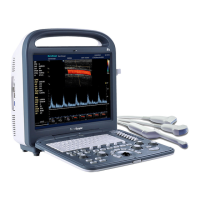S2/S2BW
Digital Color Doppler Ultrasound System
Operation Storage and transport
Relative humidity 30%∼75%, no condensation 20%∼90%, no condensation
Ambient temperature 10°C∼40°C -20°C∼55°C
Barometric pressure 700hPa∼1060hPa 700hPa∼1060hPa
13.3 Preparation and Usage of the Probe
13.3.1 Inspection
After each use, or before first use or after long-time storage of the probe, the probe must be examined for any
damages listed in the table below. Stop using the probe if any damage is found. Contact your representative
for servicing asap.
Possible damage types
Cracks on the probe handle (user section).
Cracks on the probe head (applied section).
Scratches on the probe head (acoustic window surface).
Swell of the acoustic window material.
Cracks or wear on the probe cable.
Cracks on the probe connector or any other kinds of visible damage.
Deformed pins or broken pins exist inside the probe connectors.
13.3.2 Probe Connection
Refer to Section 4.1 for detailed information on probe connection.
13.3.3 Preparation for Scanning
Attention!
•
An effective acoustic coupling does not require inordinate pressure, but it does require coupling
gel and patient contact.
•
Check the expiration date of the probe sheath and the coupling gel. Never use expired probe
sheath and coupling gel.
•
Latex or natural rubber contained inside medical equipments or accessories can cause severe
allergic reactions in some individuals. It’s suggested by FDA that the user should identify the
latex-sensitive patients and be prepared to treat allergic reactions promptly.
•
Only water-soluble coupling gel should be applied to the probe head surface. Avoid contact with
the mineral oil.
13.3.3.1 For Surface Probes
Put an adequate amount of coupling gel either on the probe head (acoustic window) or the patient skin.
If disease transmission is a concern, use of the sterile probe sheath is highly recommended. Refer to
instructions below to use the probe sheath as a barrier between the patient and the transducer surface.
13.3.3.2 For intracavitary probes
Note: The probes are provided in non-sterile condition from the manufacturer.
Intracavitary probes should be cleaned and disinfected both
before and after usage.
P/N: 4710.00149A01
13-2

